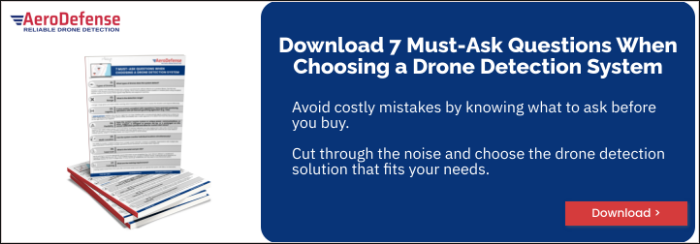Summary: Effective anti-drone security begins with real-time detection that identifies drones as soon as they enter your airspace so you can locate the pilot, assess intent, and respond.
For organizations integrating airspace awareness into their Security Operations Centers (SOCs), merging cyber and physical security data, automated alerts, and cross-functional teams is critical.
Rather than relying solely on fences or access controls, a layered anti-drone security strategy delivers clarity, early warning, and stronger defense for people, property, and intellectual assets. Anti-drone security starts with real-time detection. Integrate drone tracking into SOCs to boost response, locate pilots, and protect your airspace.
Integrating Drone Detection into Anti-Drone Security Operations Centers
Security Operations Centers (SOCs) are evolving quickly to keep pace with increasingly complex airspace activity. The most forward-thinking teams have moved beyond fence-line-only defenses and now include airspace awareness as a core element of their security strategy.
Traditional perimeter tools like fences and access control can’t detect or respond to drones. And while many drones are operated legally — for media, inspections, or public safety — unauthorized or careless flights can still present serious risks. The key is knowing which drones belong and which ones don’t — and acting accordingly.
The future of drone defense isn’t just about blocking potential threats. It’s about gaining real-time visibility, filtering out the noise, and enabling security teams to respond with clarity and confidence.
Why SOCs Need Integrated Anti-Drone Security
To be effective, modern SOCs must shift from reactive to proactive.
This requires:
- Broader data integration
- Real-time, automated alerting
- Cross-Functional collaboration between Cybersecurity and Physical Security Teams
You can’t assess intent if you don’t know where the pilot is. Real-time intelligence helps security teams respond fast and take control of the situation.
Core Capabilities Required to Execute Anti‑Drone Security
Integrating anti-drone security into the SOC enables operators to:
- Detect drones as soon as they enter your airspace
- Pinpoint the location of the controller (pilot)
- Assess the number of devices, flight path, speed, and ETA to assess threat level(s)
Drones are now required by law to broadcast information that can be detected and interpreted. This broadcast is called Remote ID, which is like a digital license plate. For many anti-drone security use cases, Remote ID detection will be enough. Remote ID detection enabled easy and cost-effective drone detection.
Conclusion: The Strategic Edge of Anti‑Drone Security
Detection isn’t a magic solution; it’s the cornerstone of anti-drone security. Not all anti-drone security solutions give an early warning of drone detection and enable a response through drone and pilot location. These are important factors to consider when selecting your anti-drone security solution.
A smart, structured defense that protects people, property, and intellectual assets.
You can learn more by reading our Ultimate Guide to Drone Detection.
Anti-Drone Security FAQs
What is meant by “anti-drone security”?
In this context, anti-drone security refers to the set of processes, technologies, and operational workflows that an organization uses to detect, identify, track (including locating the pilot), and respond to unwanted or unauthorized drone activity over its airspace.
Why can’t traditional perimeter security systems alone handle drone threats?
Traditional systems — fences, access control, intrusion sensors — are designed for ground-based threats. They cannot detect, identify, or track airborne drones, nor the associated pilot/operator.
Which key capabilities should an anti-drone security program integrate?
Core capabilities include:
-
- Detecting drones as soon as they enter the monitored airspace.
- Locating the controller/pilot on the ground (or in the vicinity)
- Assessing details like number of devices, flight path, speed, ETA, etc., to understand response urgency.
- Detecting drones as soon as they enter the monitored airspace.
How should a Security Operations Center (SOC) adapt to support anti-drone security?
SOCs must evolve from reactive to proactive by:
-
- Incorporating airspace monitoring into their dashboards.
- Enabling real-time and automated alerts when drones (or controllers) are detected.
- Encouraging collaboration between physical security and cyber teams (since drones can help conduct cyber attacks ).
Is just detecting a drone sufficient for “anti-drone security”?
No. Detection is the foundation, but you also need to assess who is flying by having pilot location capability and what their flight path is. Only with that information can you escalate to response and action. Detection isn’t a magic solution… but it’s the cornerstone of anti-drone security.
How does “pilot location” factor into anti-drone security?
Many systems focus only on the drone craft, but locating the pilot is essential in order to be actionable — you can disrupt the operator from continued flight, communicate with them, identify intent, and involve law enforcement if needed.
What should organizations consider when selecting an anti-drone security solution?
They should ask:
-
- Does the system detect both drones and the pilot location?
- Does the system detect many manufacturers?
- Is it integrated with existing SOC workflows and alerting systems?
- How scalable/flexible is it for different sites or events?


